A deserted village in a deserted forest / Un village abandonné dans un désert forestier
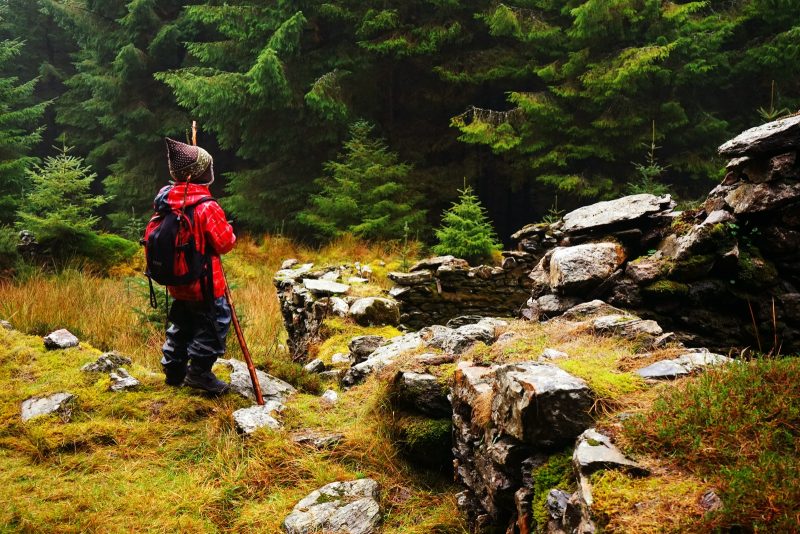
In the heart of the Wicklow Mountains, above Lough Dan, the deep dark woods along the Wicklow Way suddenly open up to reveal a long abandoned Scotch village that has been overtaken by nature.
Walking with our friend Mary Ann and her sons, the acorns clocked up nearly 10km and over 16,000 steps (many more for Pebbles’ little legs, no doubt), on a damp November day, to reach the deserted settlement, an eerie place I knew nothing about until the hiking app Hiiker (affiliate link) mentioned it on Instagram a few weeks prior.
Au cœur des monts de Wicklow, au-dessus de Lough Dan, les bois noirs qui bordent le Wicklow Way s’ouvrent soudain pour révéler un village abandonné depuis longtemps, où la nature a repris ses droits.
Accompagnés de notre amie Mary Ann et ses deux fils, les graines de chêne ont parcouru presque 10 km et quelque 16 000 pas (plus que ça pour Caillou), par une journée humide de novembre, pour atteindre ce lieu unique dont je ne savais rien il y a tout juste trois semaines.
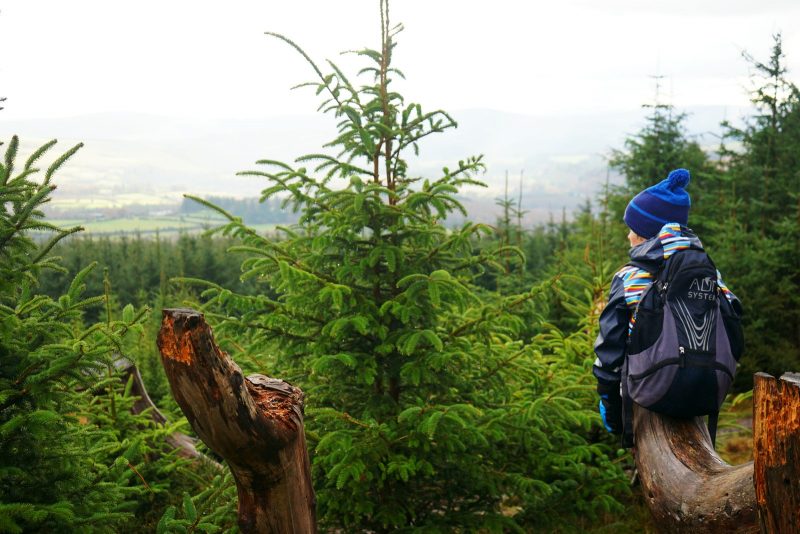
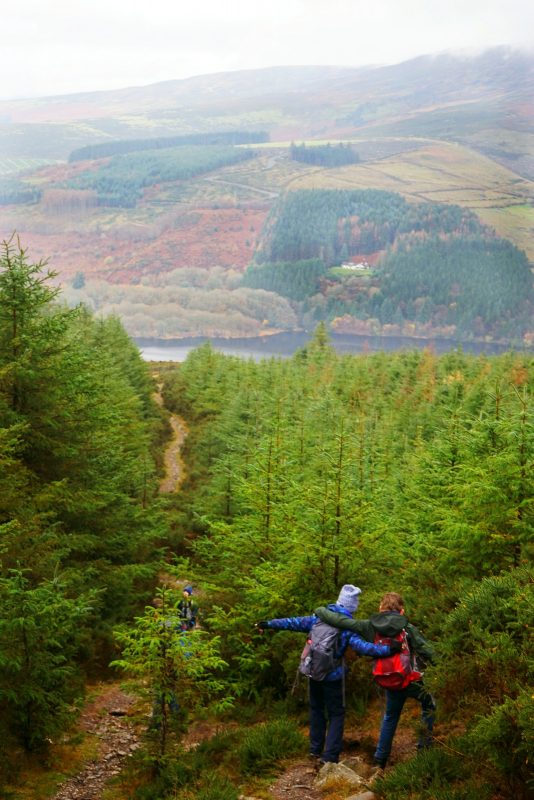
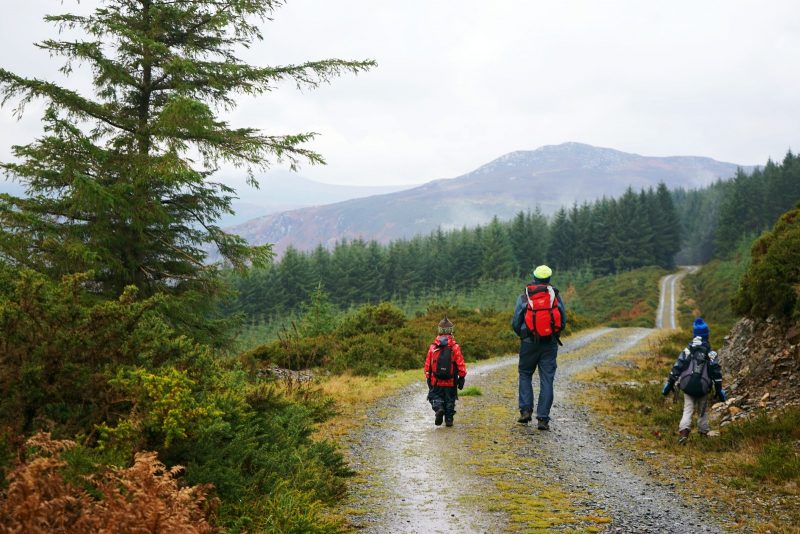
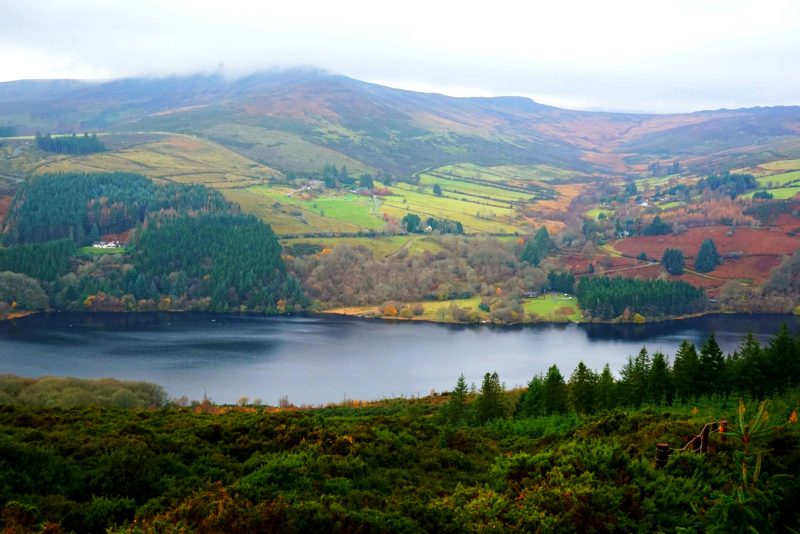
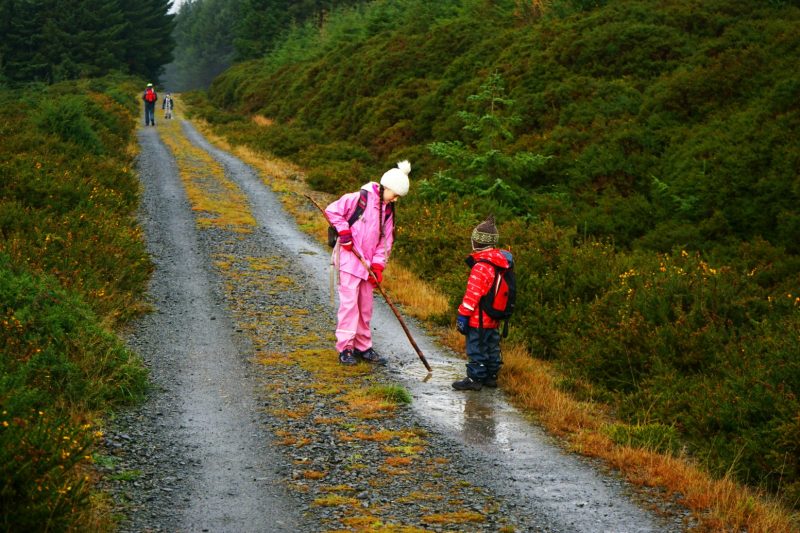
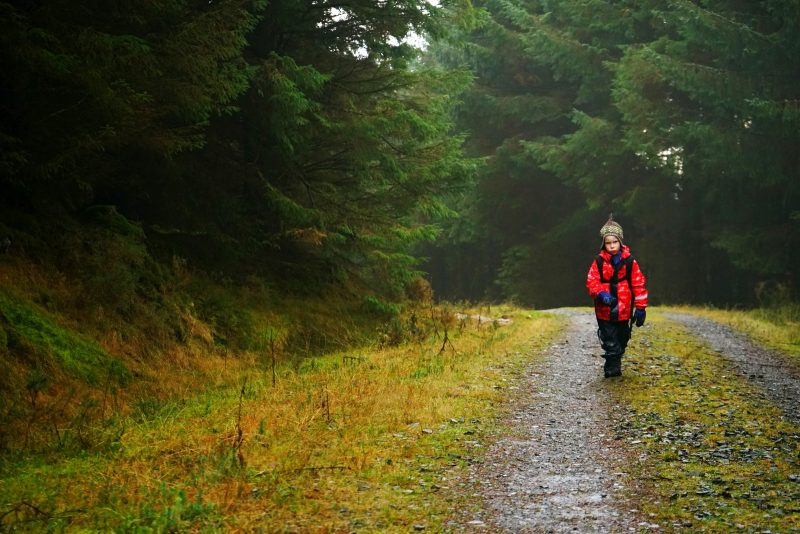
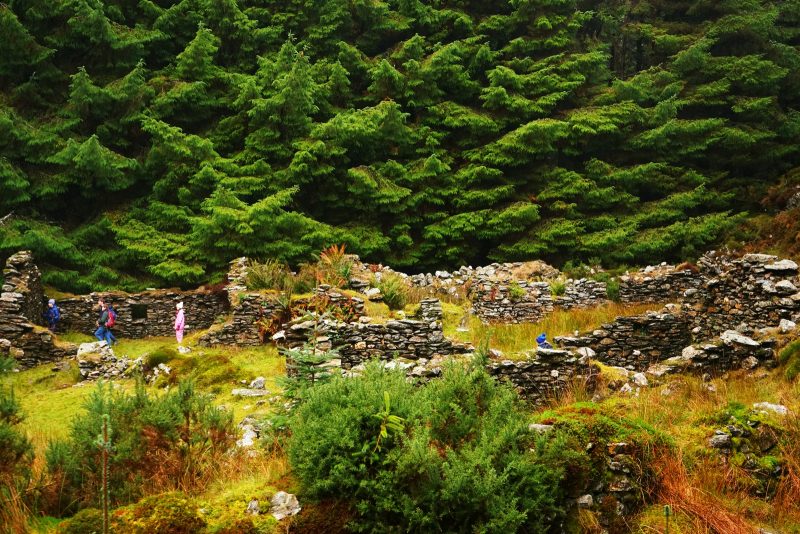
Located on the Ballinrush side of the Luggala valley, the so-called Scotch village is often said to have been home to Scottish farmers who emigrated to Canada during Ireland’s Great Hunger (1847-1850).
Yet, according to local historian Chris Corlett in his article for the Roundwood Historical Journal, “settlement in Ballinrush continued for another century”, i.e. until the 1950s.
(You can read The Ruined Farmhouses of the Cloghoge and Inchavore Valleys here.)
The remote Scotch village is enclosed by a thick stand of conifers, with mossy dry-stone walls crisscrossing the forest floor into the distance. The silence is deafening, the mood undoubtedly eerie.
With the mist slowly lifting from the tree tops, we set up camp inside one of the roofless houses. Brian lit the MSR stove (affiliate link) for our usual bowl of trailside noodles, while the acorns and Mary Ann’s sons explored the ruins of the Scotch village – a cluster of three small houses with their haggards and gardens.
The Shorter Oxford Dictionary, dating “haggard” from 1586, says this word from Old Norse is found only in Ireland and the Isle of Man, and means “a haystack”. Generally in Ireland the word embraces the area near the house where the grain- and hay-stacks were built.
Situé sur le lieu-dit Ballinrush dans la vallée de Luggala, le village dit “écossais” aurait abrité des paysans d’origine écossaise qui émigrèrent au Canada pendant la Grande Famine (1847-50).
Cependant, un historien local du nom de Chris Corlett explique, dans un article publié dans le Roundwood Historical Journal, que le hameau fut habité jusqu’aux années 1950, soit pendant un siècle de plus.
Loin de tout, le village écossais est cerné par une épaisse forêt de conifères, avec sous les hauts arbres, un enchevêtrement de murs de pierre sèche à la fonction depuis longtemps oubliée. Le silence y est assourdissant, l’ambiance indubitablement étrange.
Comme la brume s’élevait lentement au-dessus des arbres, nous avons planté le camp dans une des maisons en ruines. Brian alluma le réchaud MSR (lien partenaire) pour notre incontournable bol de nouilles instantanées, pendant que les graines de chêne et les deux garçons de Mary Ann exploraient les ruines du village écossais – trois masures de pierre, avec leurs jardins et fenils adjacents.
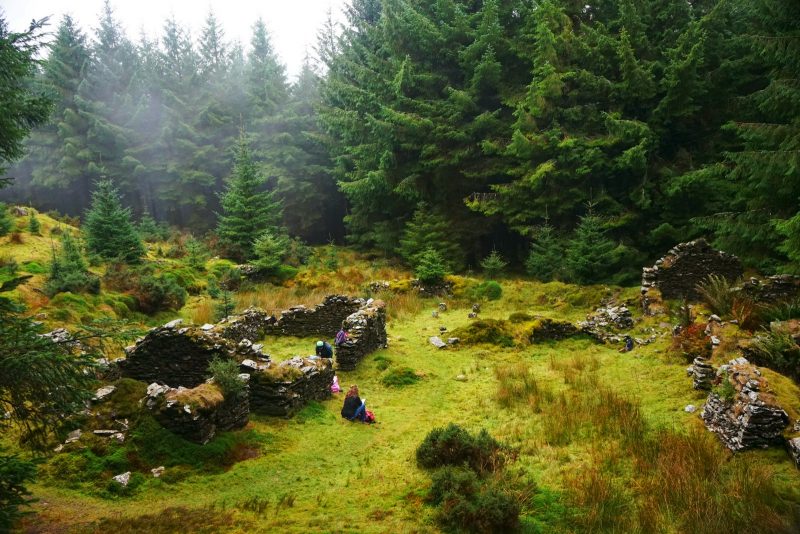
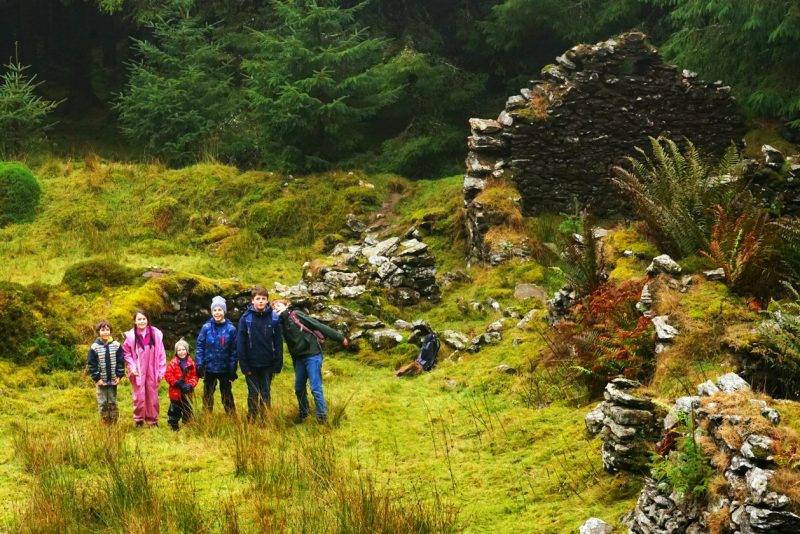
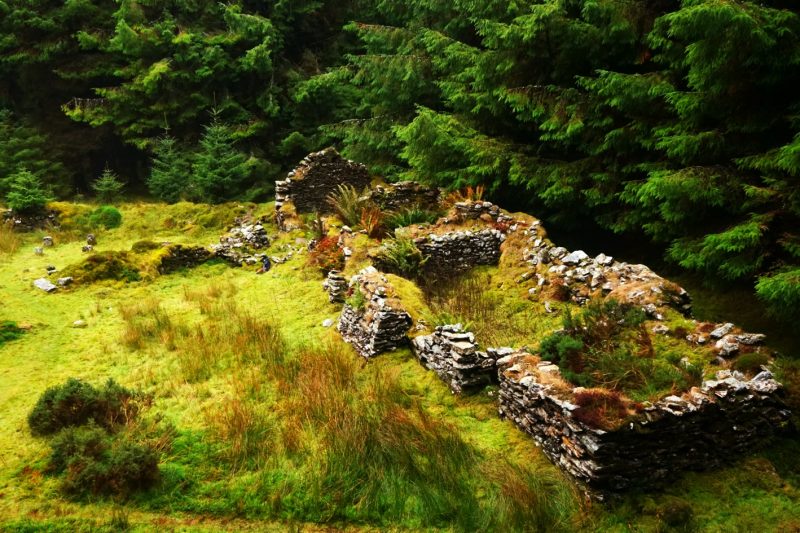
The 4 stone pillars on the left-hand side are the remains of a corn stand, used to dry and store grain (oats in Wicklow) /
Les quatre pierres en carré sur la gauche de l’image sont les vestiges d’un grenier, jadis utilisé pour sécher et conserver le grain (avoine).
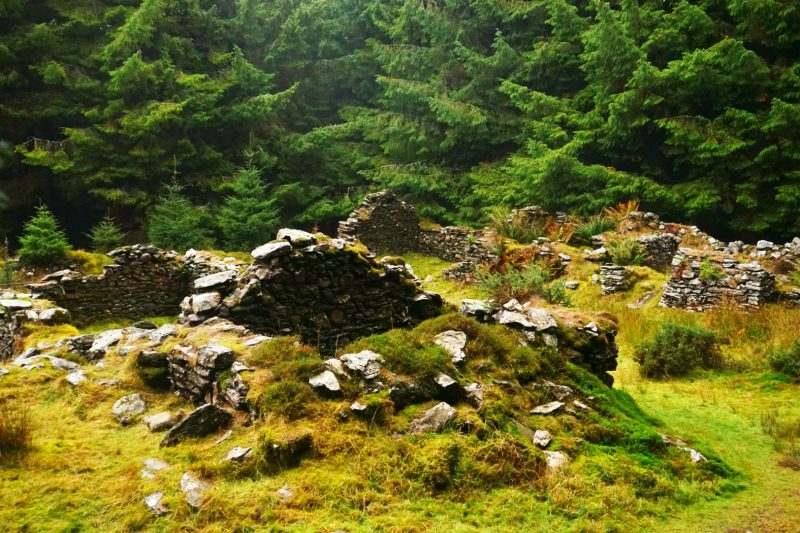
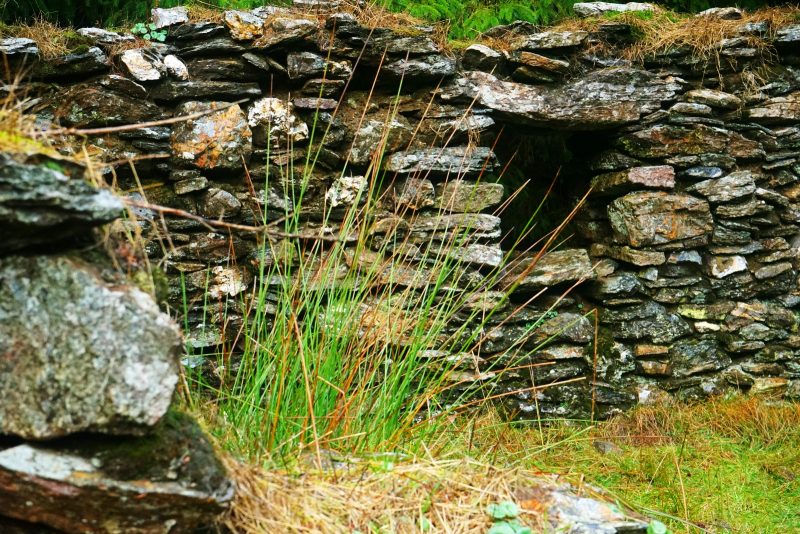
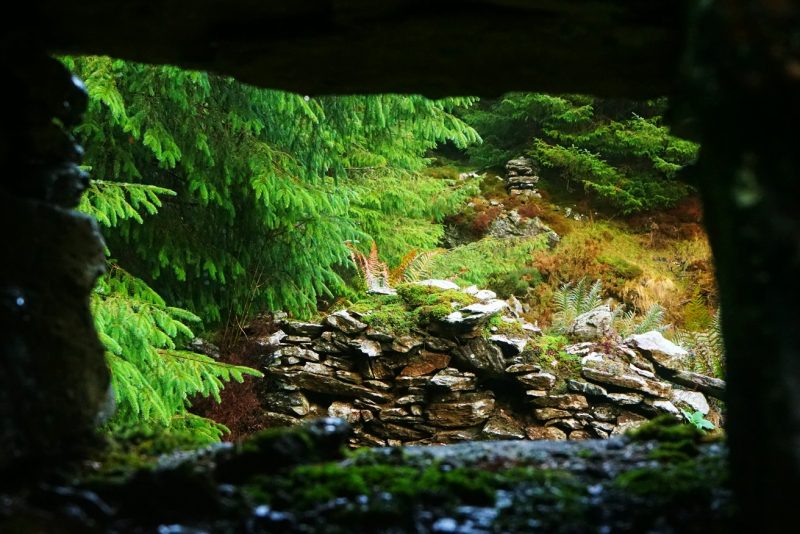
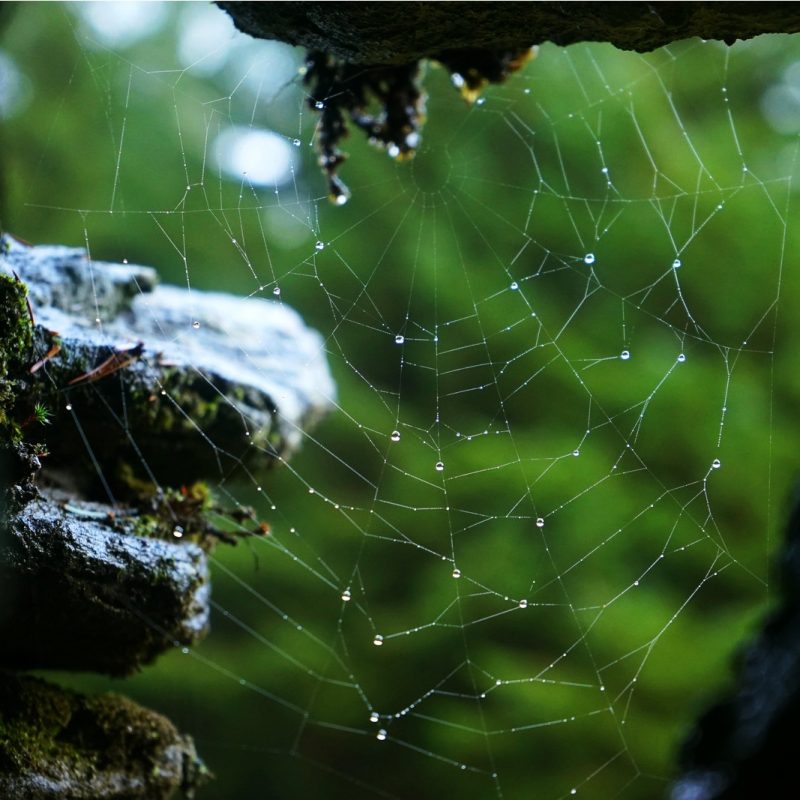
Droplets on a spider web at the Scotch village /
Toile d’araignée mouillée entre les pierres du village abandonné.
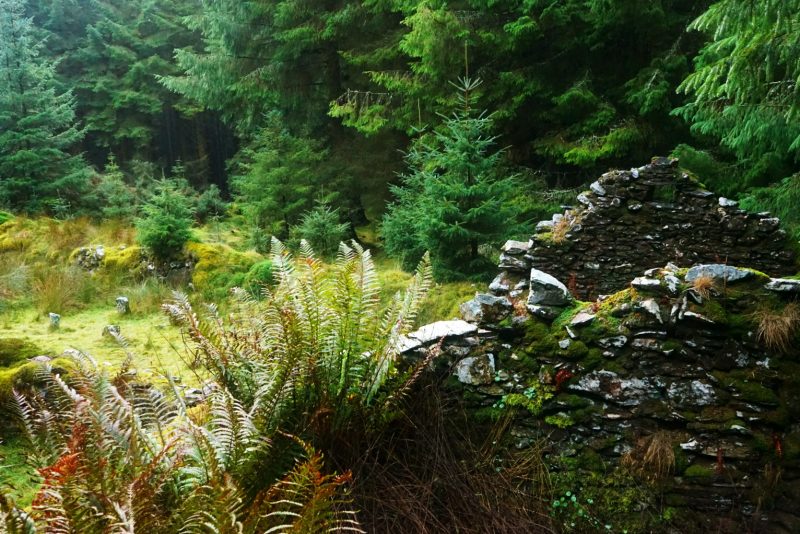
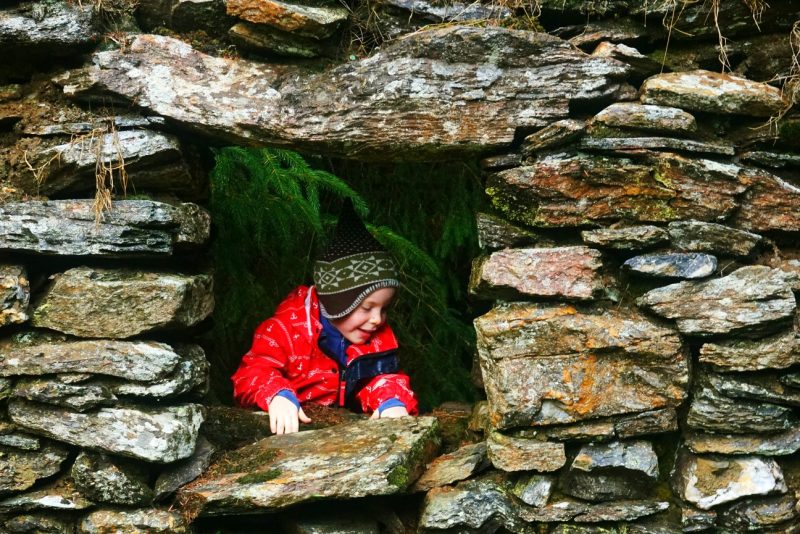
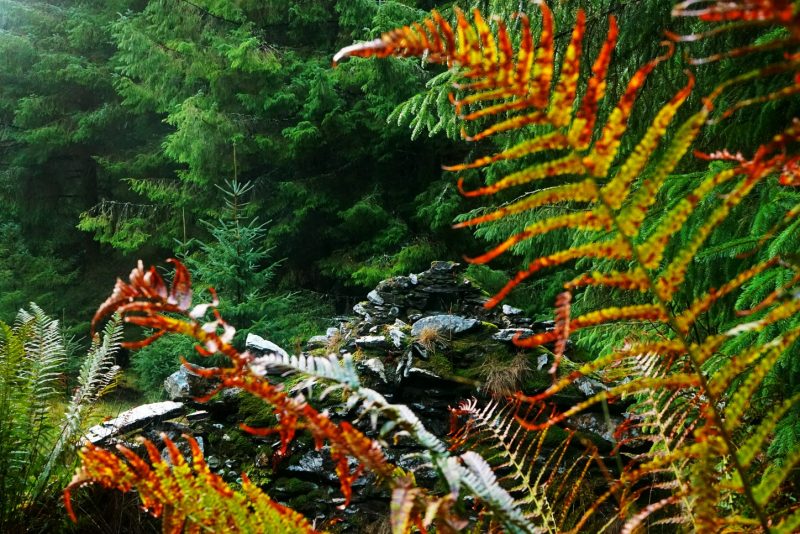
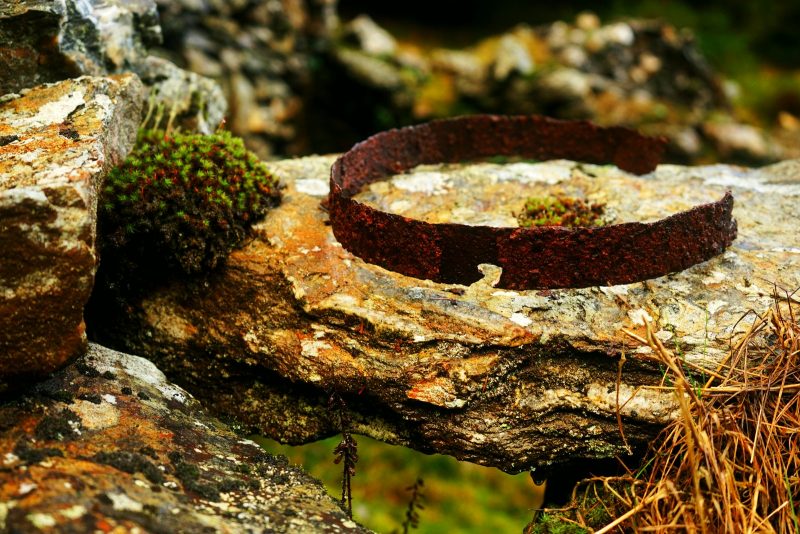
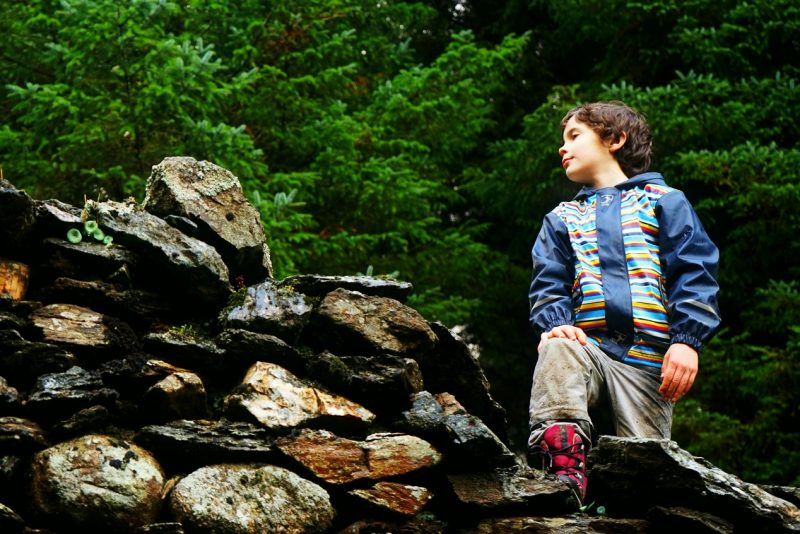
Soon the acorns and the two boys disappeared beyond the Scotch village ruined walls, into the coniferous forest planted on what used to be the village fields.
A deserted village in the midst of a deserted forest
While the older boys played fight with sticks, Squirrel and Pebbles started building a den and a fire tripod in the deep dark wood.
Bientôt les graines de chêne et les deux garçons disparurent au-delà des ruines du village écossais, pour s’enfoncer dans la forêt plantée sur les anciennes terres agricoles du hameau.
Un village déserté dans un désert forestier
Pendant que les plus grands se pourchassaient et se bagarraient avec des bâtons, Ecureuil et Caillou entreprirent de construire une cabane dans la pénombre humide.
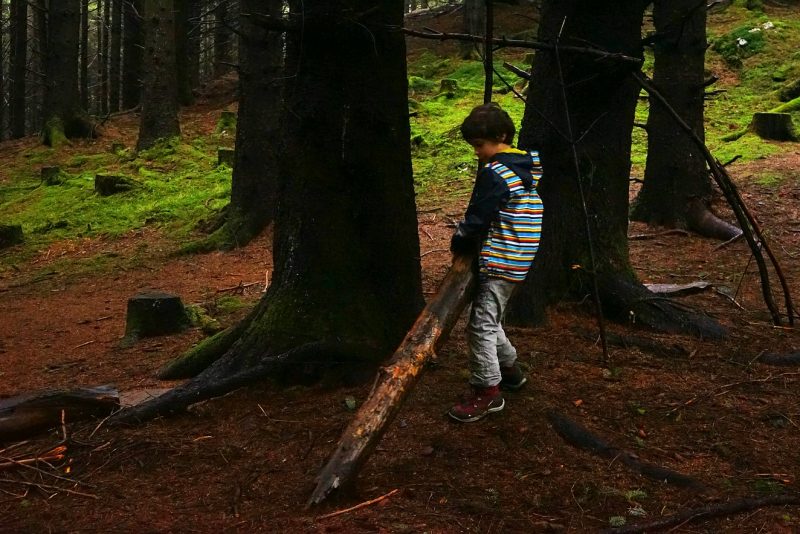
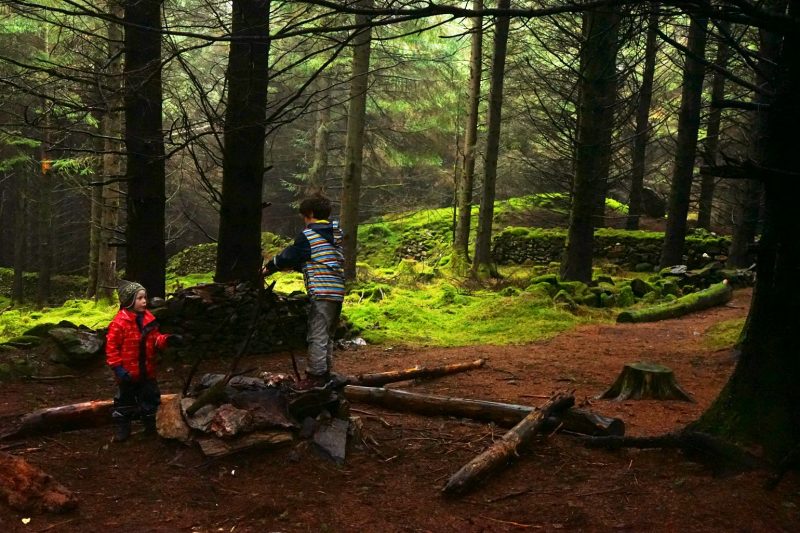
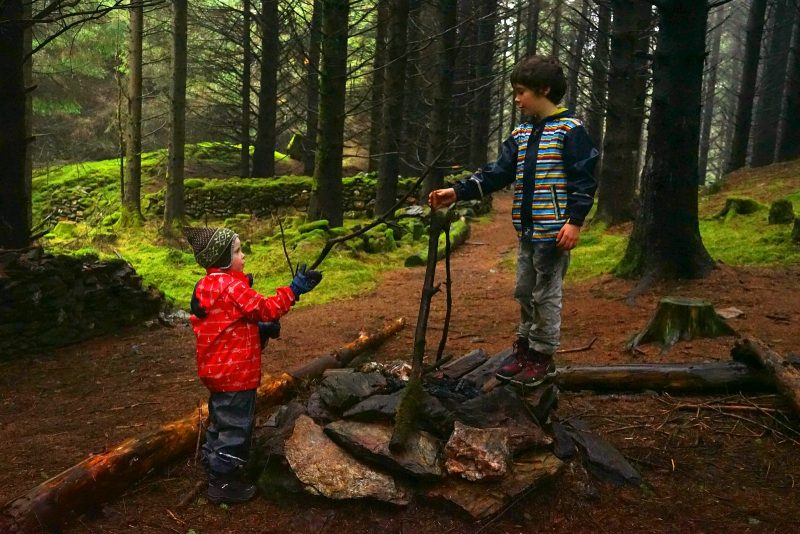
Under the tall trees, only the echo of the children’s voices and the occasional crack of a branch underfoot broke the silence. The soft ground was covered in dried needles, with here and there a pool of bright green moss where a hole in the impenetrable canopy let the sunlight through to the forest floor. In the uniformly brown gloom, the orange filaments of a stagshorn mushroom easily caught my eye.
This forest was little more than a desert – read more on the problem with Ireland’s coniferous plantations.
What a contrast with the lush, colourful abundance of Clara Vale, which we had explored only a few weeks earlier!
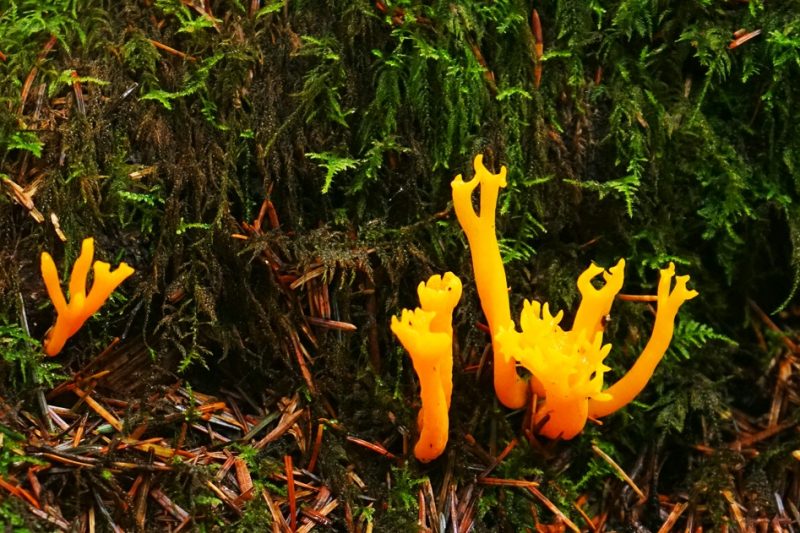
Stagshorn fungus / Calocère visqueuse (Calocera viscosa)
Sous les hauts arbres, seul l’écho des voix des enfants et le craquement intermittent d’une branche sous les pieds brisaient le silence. Le sol moëlleux était tapissé d’aiguilles sèches, avec çà et là un cercle de mousse vert brillant, là où un trou dans la canopée impénétrable créait un puits de lumière. Dans la pénombre uniforme, les filaments oranges d’une calocère visqueuse attirèrent mon regard.
Cette forêt était un désert. Quelle différence avec la luxuriance colorée de Clara Vale, que nous avions visité quelques semaines plus tôt !
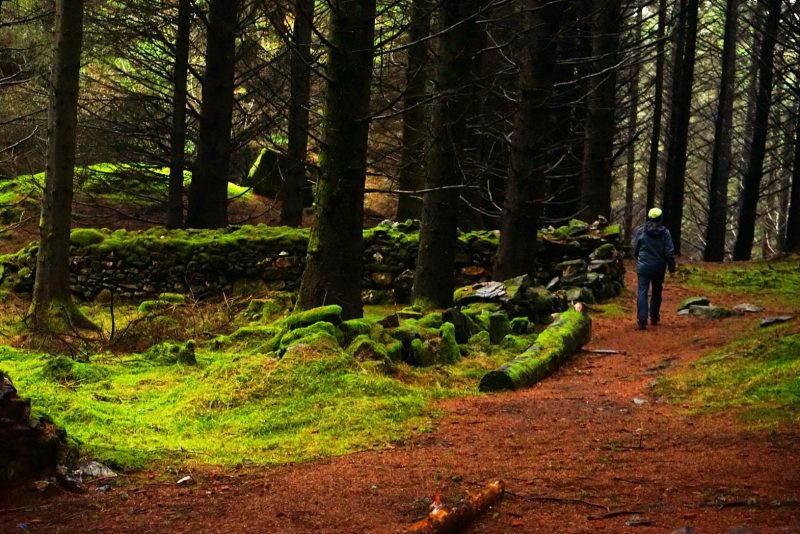
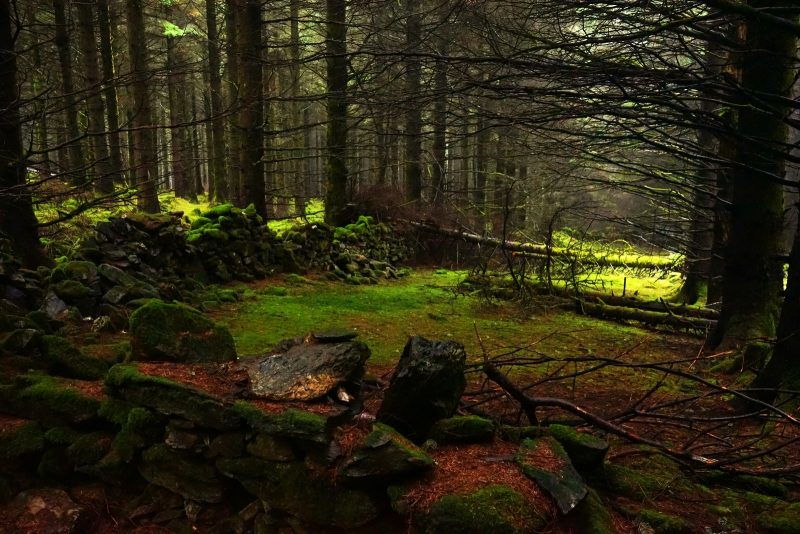
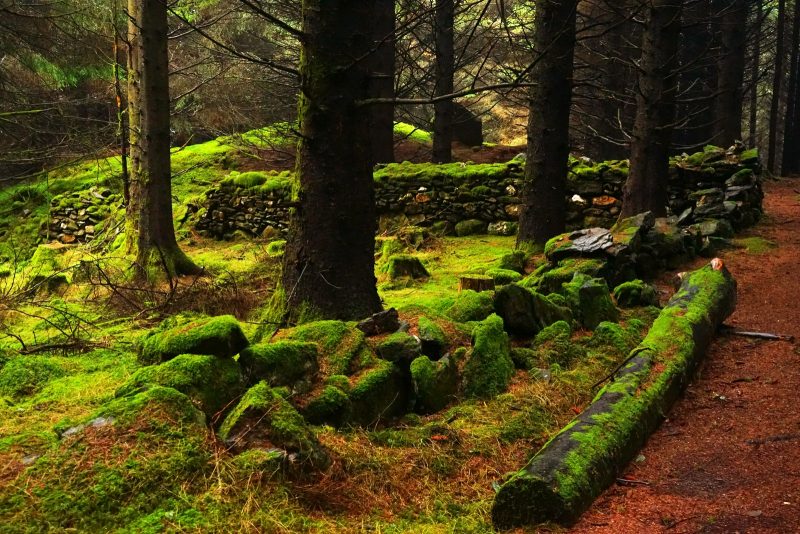
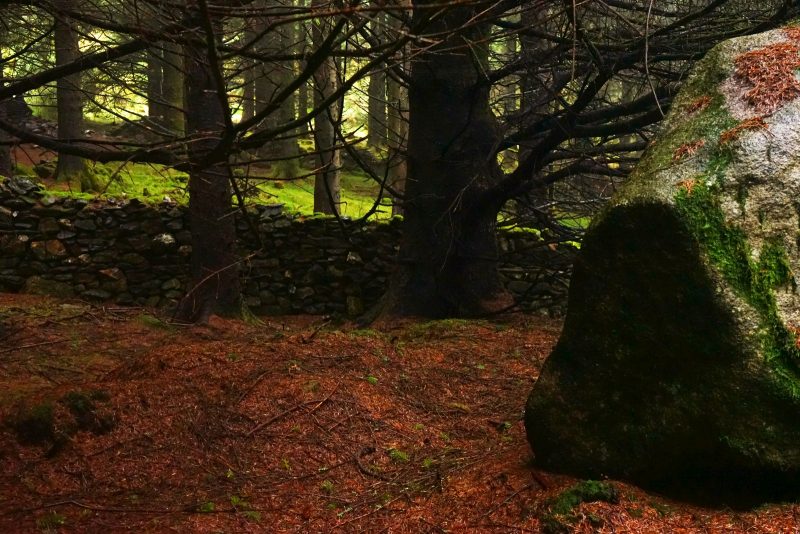
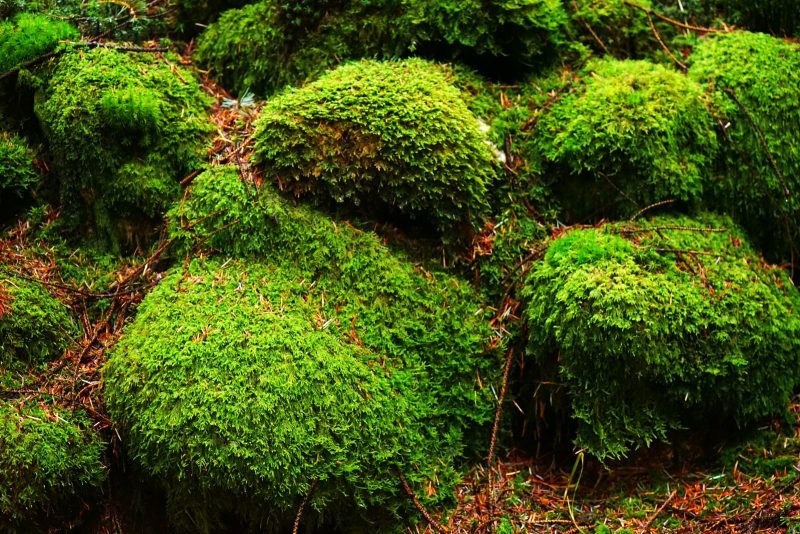
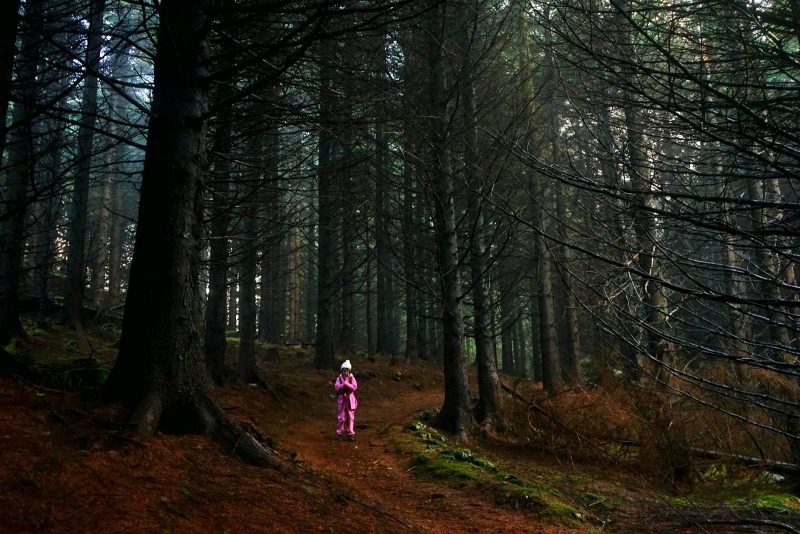
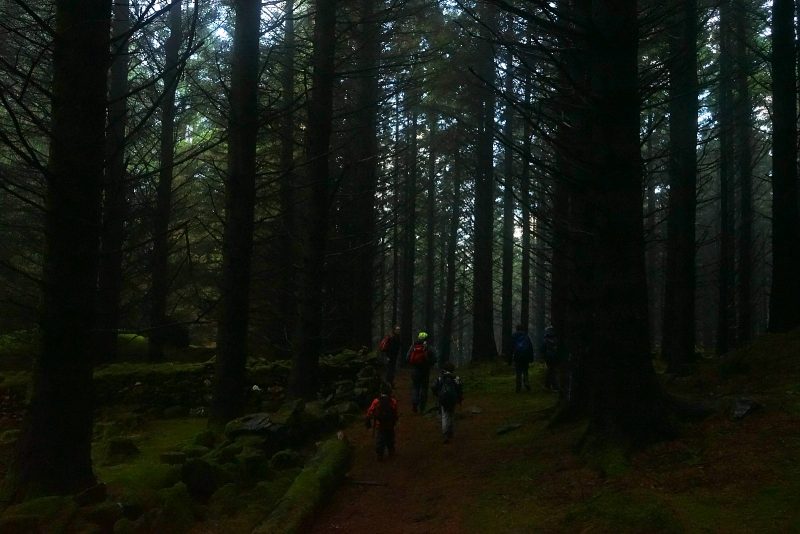
What a relief it was to come out of the dimness to this breathtaking view – one of my absolute favourites in Wicklow, if not the whole of Ireland.
Quel soulagement ce fut d’émerger des ténèbres pour découvrir ce paysage d’une beauté époustouflante – un de mes préférés de Wicklow, si ce n’est de l’Irlande entière.
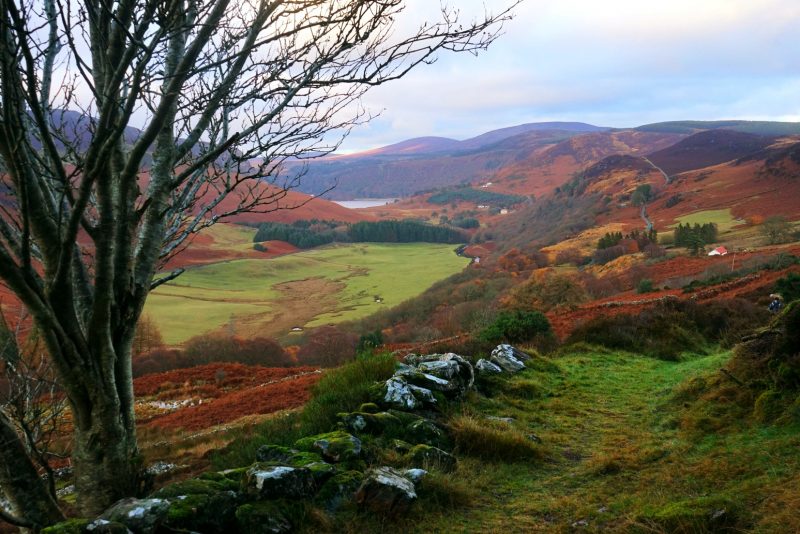
As the sun slowly set over the Wicklow Mountains, painting the rounded summits and russet hillsides in dusky pinks and delicate purple, Lough Tay shimmered up ahead while Lough Dan looked somber down below.
I thanked our lucky stars that the best part of this family hike was yet to come. Had we started this loop walk the other way, the valley would have been engulfed in drizzle and mist, with a few hailstones thrown in for good measure.
The Scotch village is one of many deserted farming settlements scattered across the old estates of Ballinrush on this side of the Cloghoge River, and Luggala across the way. Crumbling stone walls, cultivation ridges and ruined houses still dot the beautiful valley.
Comme le soleil descendait lentement sur les monts de Wicklow, peignant de rose et de violet les sommets arroundis et les versants fauves, Lough Tay miroitait haut devant tandis qu’en contrebas, Lough Dan sombrait dans le crépuscule.
Quelle chance que le meilleur de cette randonnée soit encore à venir ! Si nous avions commencé par là, la vallée aurait été plongée dans la bruine et les nuages, avec quelques grêlons pour finir.
Le village écossais n’est qu’un de plusieurs hameaux abandonnés çà et là sur les anciens domaines de Ballinrush et Luggala, de l’autre côté de la rivière Cloghoge. La vallée reste parsemée de murets de pierre croulants, sillons de culture agricole et maisons en ruines.
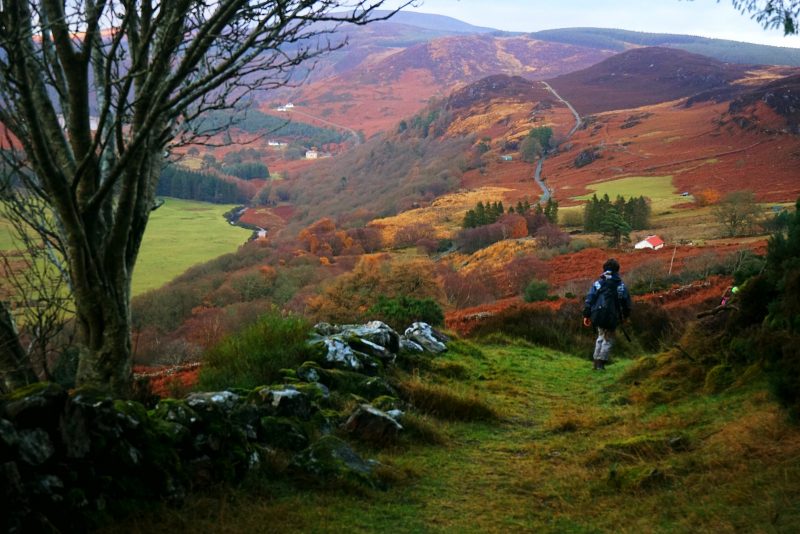
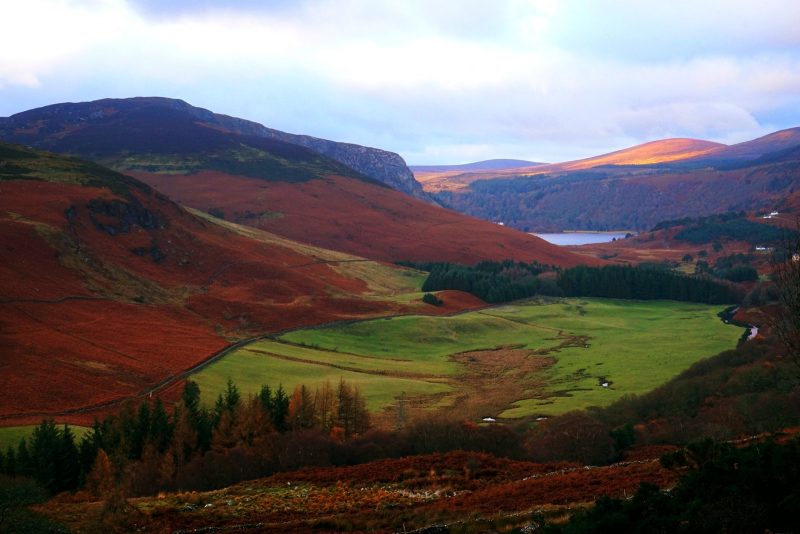
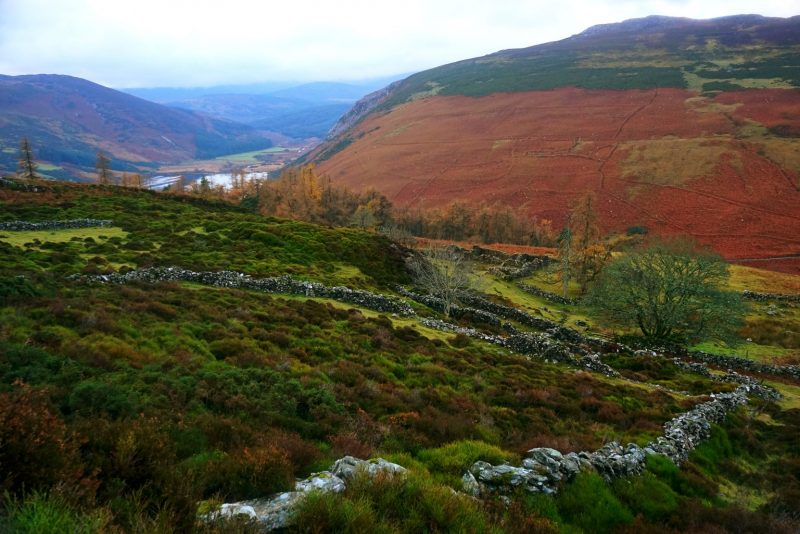
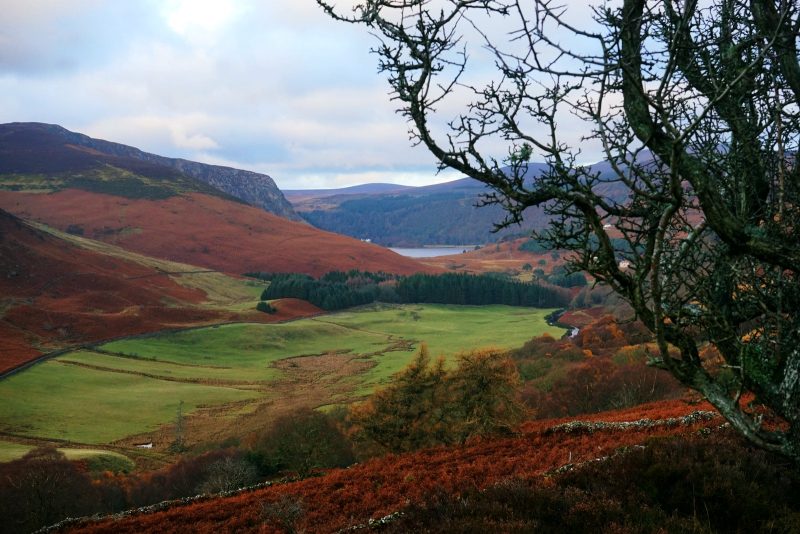
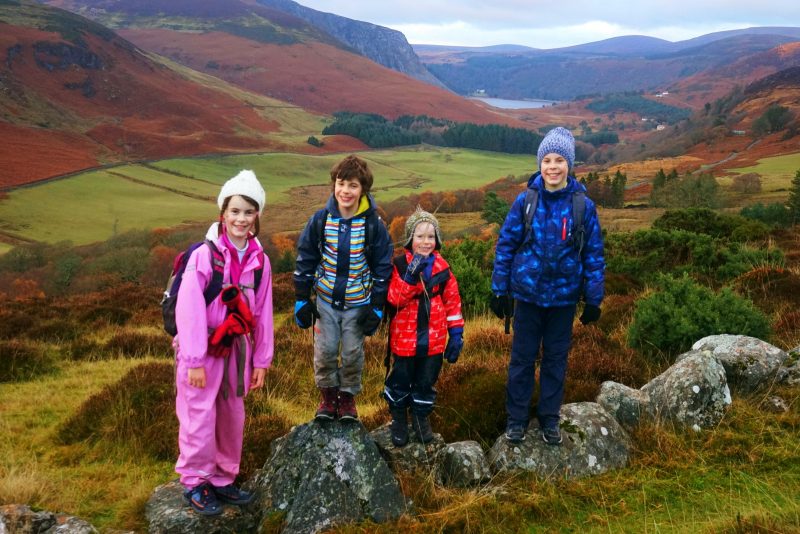
By the time we found the Wicklow Way again, the entire valley was bathed in the cool blues of dusk.
Soon the head torches were switched on, as little legs were tiring and the pace slowed down to a crawl in the incoming darkness.
“What is the best seat in the world?” Pebbles asked as we neared the car. I replied with another question, “I don’t know. What do you think?”
“It is my car seat!” he answered with a cheeky smile.
That’s it: 10km and 16,000 steps to the Scotch village, and a child’s car seat will feel like the greatest throne in the world!
Quand nous avons enfin rejoint le Wicklow Way, la vallée tout entière baignait dans les tons bleus du crépuscule.
Bientôt les lampes frontales furent allumées, comme les petites jambes commençaient à fatiguer et l’allure se réduisait à un pas d’escargot dans l’obscurité grandissante.
“Quel est le meilleur siège du monde ?” demanda Caillou comme nous approchions de la voiture. Je répondis avec une autre question : “Je ne sais pas. Qu’est-ce que tu en penses ?”
“C’est mon siège dans la voiture !” s’exclama-t-il avec un sourire coquin.
Et voilà : 10 kilomètres à pied, soit 16 000 pas, et le siège auto d’un enfant devient le plus beau trône du monde !
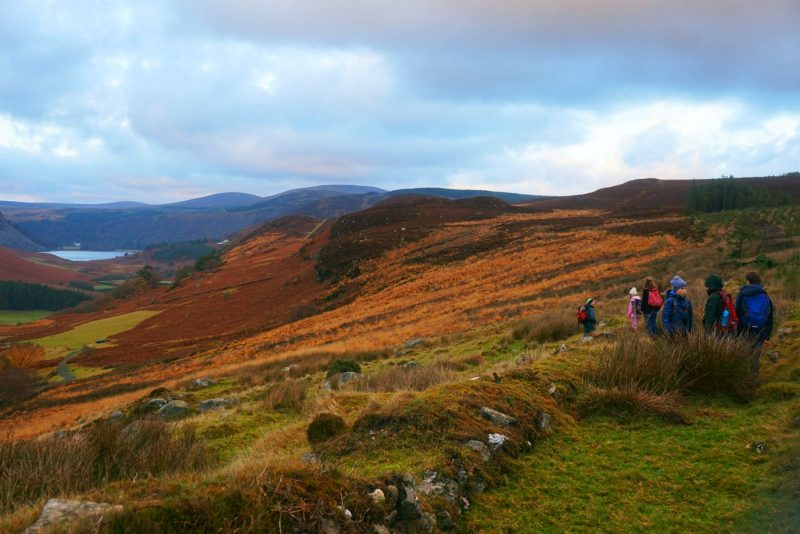
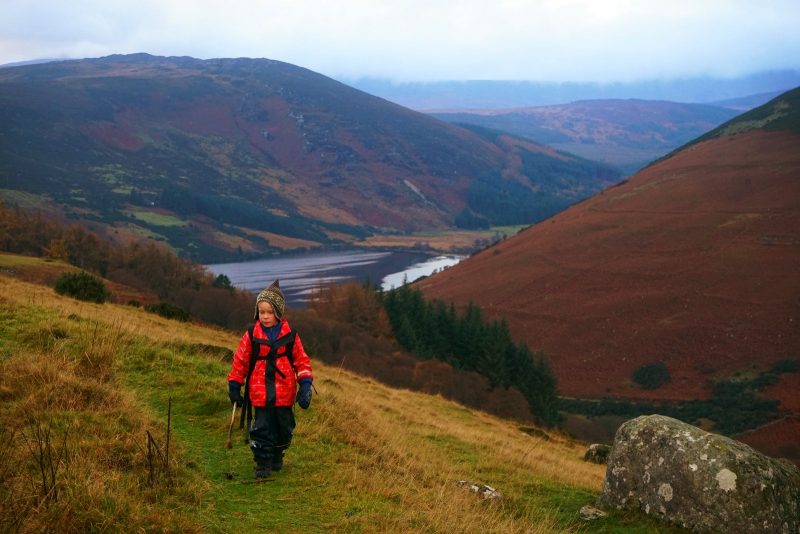
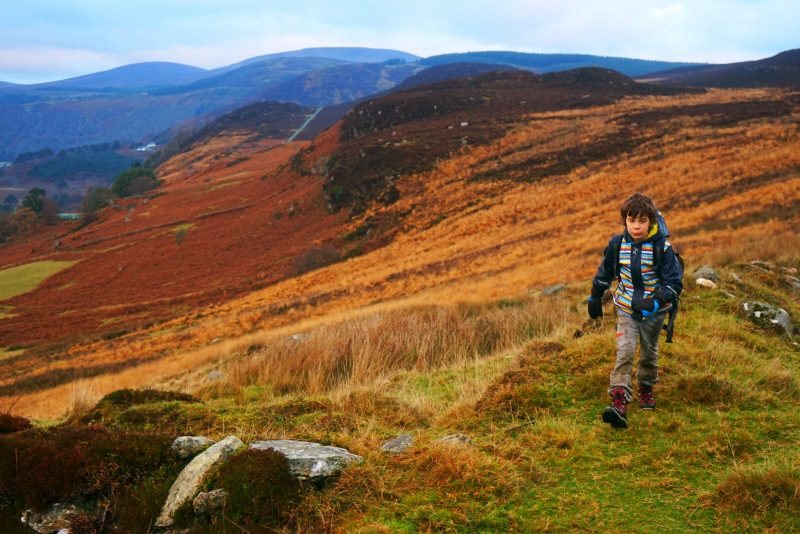
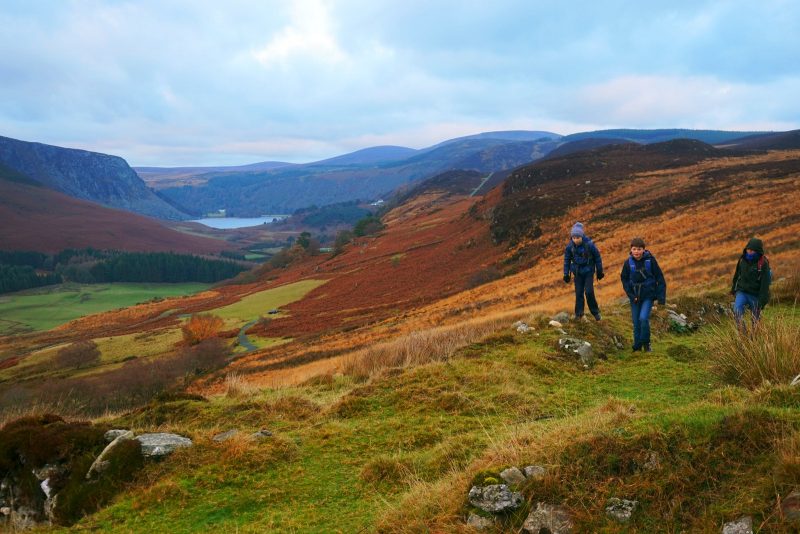
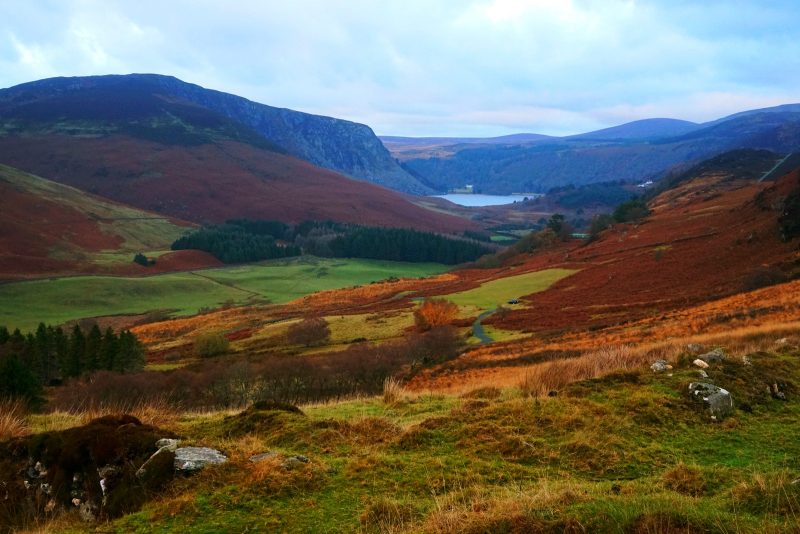
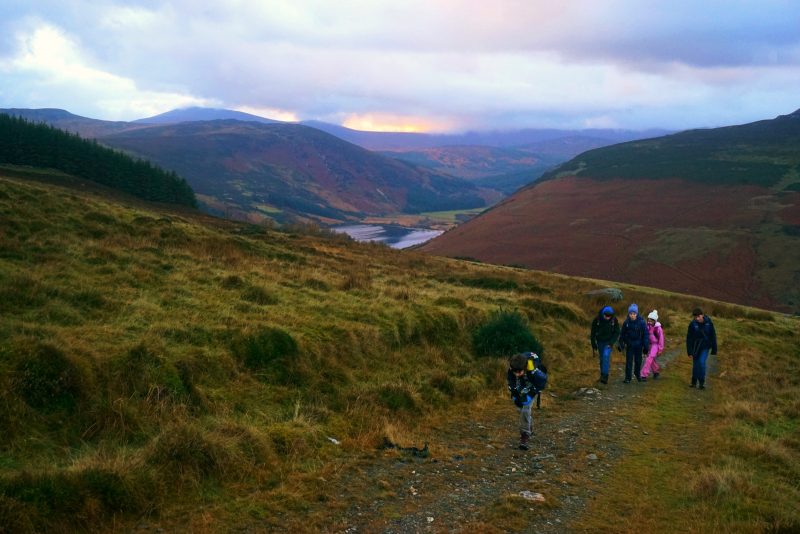
Getting there
Travelling northbound (Dublin) on the N11, take Exit 8 (Kilmacanogue), then the first exit on the roundabout, signposted for Roundwood and Glendalough (R755). At the next roundabout, take the second exit and continue straight ahead on the R755.
Travelling southbound (Wexford) on the N11, take Exit 8 (Kilmacanogue), immediately after the Circle K petrol station, following signposts to Roundwood and Glendalough (R755). At the roundabout, take the last exit, to Kilmacanogue and Roundwood (R755). At the next roundabout, take the first exit for the R755.
Follow the R755 for 11km, then turn right onto the R759, signposted for Sally Gap. Drive 4km up this road to a wayside car park on the left with a Wicklow Way signpost.
S’y rendre
Circulant en direction du nord (Dublin) sur la N11, prenez la sortie 8 (Kilmacanogue) puis, au rond-point, la première sortie, en direction de Roundwood et Glendalough (R755). Au deuxième rond-point, prenez la deuxième sortie et continuez tout droit sur la R755.
Circulant en direction du sud (Wexford) sur la N11, prenez la sortie 8 (Kilmacanogue), tout de suite après la station service Circle K, et suivez les panneaux indiquant Roundwood et Glendalough (R755). Au rond-point, prenez la dernière sortie pour Roundwood et Glendalough (R755). Au rond-point suivant, prenez la première sortie pour la R755.
Continuez sur la R755 pendant 11 km, puis tournez à droite sur la R759, indiquant Sally Gap. Continuez sur cette route pendant 4 km environ jusqu’à un parking de fortune en bord de route à gauche, marqué d’un panneau du Wicklow Way.
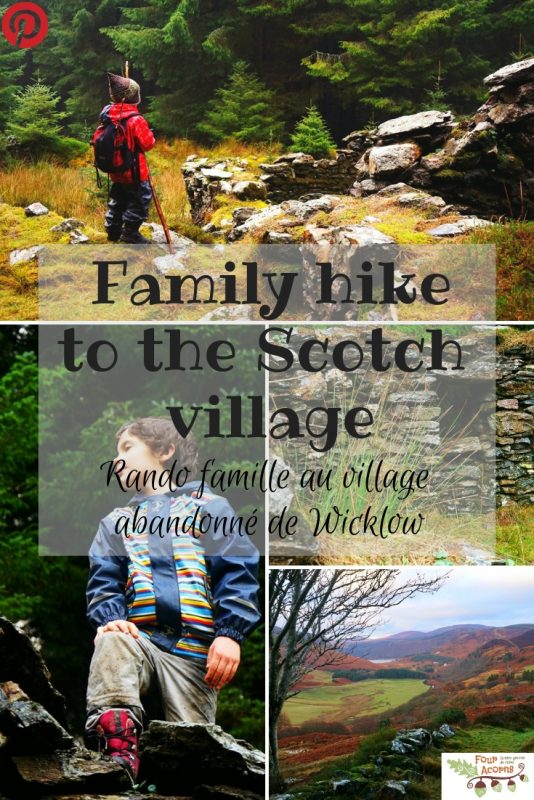
The problem with Ireland’s coniferous plantations
Such coniferous plantations as seen around the Scotch village are typical of Ireland’s forestry model. For well over a century, Sitka spruce has been planted all over the country, in an effort to increase tree cover and generate income from lands perceived as unproductive – uplands and boglands where no other crops will grow.
A non-native monoculture
If these plantations look out of place in the Irish landscape, that’s because they are. Conifers are not native to Ireland, although the cool and damp conditions suit them perfectly.
While native woodlands are a living ecosystem teeming with wildlife, coniferous forests are but an intensively farmed monoculture – zombie forests, as they are often dubbed. The associated spraying of pesticides to ward off pine weevil and other pests also kills whatever insects and microorganisms are left in the permanent gloom.
When a coniferous plantation reaches maturity, it is clear-felled with heavy machinery, leaving an unsightly waste ground of tree stumps and rotting branches on vasts tracts of land, in even the most scenic locations of the country. (We walked past one such clear-felled area at the very start of our hike to the Scotch village.) The impoverished layer of top soil, along with pesticide residues, is then easily washed off by rainfall into nearby lakes and rivers, thus polluting the entire water system.
Not so green after all
Because trees capture cardon dioxide from the atmosphere through photosynthesis, forests act as carbon sinks, or carbon storage, for our greenhouse gas emissions. Thus afforestation, i.e. the planting of trees, is an important tool in the fight against climate change.

The Woodland League campaigns for the restoration of Ireland’s native woodlands
But not all trees are created equal in the carbon storage stakes – yet again, fast-growing conifers come up short compared to deciduous trees. Indeed, “the proliferation of coniferous trees has reduced the carbon storage capacity of Europe’s forests”, according to two studies published in 2016.
Forests not equal when it comes to climate – Jeff Tollefson, Nature, 4th Februrary 2016
Save Leitrim
In the west of Ireland, half of all agricultural land in tiny Co Leitrim is planted in non-native Sitka spruce. In early 2018, a group of concerned local people launched Save Leitrim to try and stop coniferous afforestation.
“We are most definitely not against trees! We are for the right trees, in the right places being managed in the right way so that everyone benefits! The environment, the wildlife, the communities, the farmers, the economy, the county and the future.”
Ireland’s native woodlands are quietly disappearing – Darragh Murphy, The Irish Times, 19th June 2018
 Environmental NGOs such as the Woodland League and the Native Woodland Trust have been campaigning for decades for the conservation and restoration of Ireland’s forests with native deciduous trees such as birch, ash, holly, oak, beech, etc. Nonetheless, the state-incentivised planting of Sitka spruce continues.
Environmental NGOs such as the Woodland League and the Native Woodland Trust have been campaigning for decades for the conservation and restoration of Ireland’s forests with native deciduous trees such as birch, ash, holly, oak, beech, etc. Nonetheless, the state-incentivised planting of Sitka spruce continues.
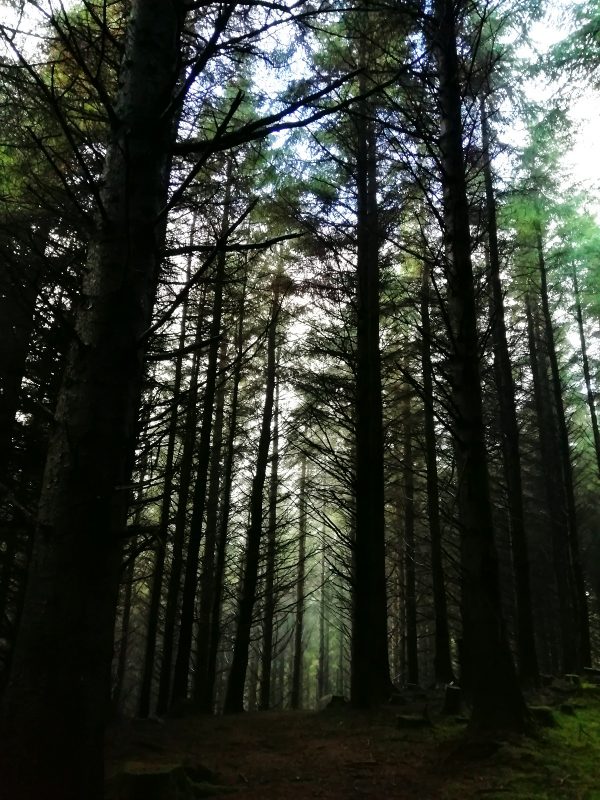
Disclosure: This post contains some affiliate links. Should you choose to make a purchase after clicking on one of them, I may receive a small commission and your purchase will help support this site.
Avertissement : Cet article contient des liens partenaires. Si vous décidez d’effectuer un achat après avoir cliqué sur l’un d’eux, je recevrai une commission qui contribuera à soutenir ce site.
More family hikes in Wicklow / Autres randos familiales en Wicklow
- An ice-breaking hike to Djouce Mountain / Randonnée brise-glace au mont Djouce
- Lough Dan – Walk to the lake side / Randonnée côté lac
- On Glendalough’s beaten track / Sur le sentier battu de Glendalough
- Seefin – Hiking up a hill and back in time / Randonnée à remonter le temps
- Tonelagee, the “heart” of Wicklow / Tonelagee, au cœur de Wicklow
- 7 tips for hiking with kids / 7 conseils pour la randonnée en famille




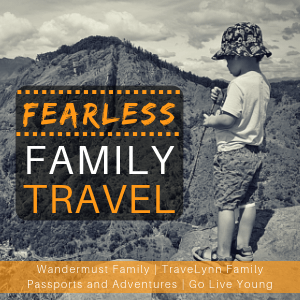


 Previous Post
Previous Post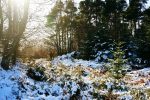 Next Post
Next Post
My goodness what a hike that was, but with such stunning scenery how could you not love it. What a great adventure and finding the old settlement a real treat. We have a few Cornish settlements like this, it’s always great to stumble upon them and find out a little about their history. #CountryKids
Wow! Even just the title of this got me excited! This looks like the type of day my son would love, and me too! It looks like you had a great day surrounded by beautiful scenery. And how exciting to visit a deserted village (even though it’s been reclaimed by nature) and imagine the people who lived there all those years ago! #CountryKids
There is something wonderful and magical about ruins. I recall Glendalough being of particular beauty in my eyes. #CountryKids
What a fascinating and eerie place to explore and so interesting to read the history behind it. I can’t help trying to imagine what it might have looked like when the cottages were occupied and what the people were like who lived in them. We have a ruined house a short walk away from us which we pretend is a witch’s cottage – it is fascinating but lacks the eerie beauty of the Scotch Village. I’ve never seen a stagshorn mushroom before – it is quite striking. The views across the Wicklow Mountains on your hike back are absolutely stunning. I am sure getting to sit down in the car seat after such a long hike was very much appreciated! Thanks for sharing with #CountryKids
This post and the photos, while beautiful and a monumental adventure for your Acorns, spoke to me of abandonment and loss. It’s amazing how nature has already claimed back the ancient settlement leaving the evocative windows and ruined walls full of mystery. I didn’t know about the damage of coniferous farming but reading about it made sense of my feelings! Brilliantly written as ever and kudos to your stalwart children and car seat thrones!! Thanks for sharing with us at #CountryKids
Lovely photos, such vivid colours. I think we have a similar problem with pine trees here in the UK, I’ll have to find out more. #Fearlessfamtrav
These ruins sound fantastic! We love getting outside with our little one too #fearlessfamtrav
Beautiful photos! This place looks like a stunning location for a hike. Seems like you had a bit of a soggy day though! Interesting to read about the different trees and their carbon crushing powers – I never know that. Thanks for sharing. #farawayfiles
What beautiful photographs. Sounds like a wonderful hike with the addition of some great ruins. Thank you for airing with #fearlessfamtrav
What a great hike and well worth it for those astounding views. No wonder it’s one of your favourites in Ireland. I love that you get your kids out and about in all weathers. Thanks for sharing on #FarawayFiles
Your post has made me so eager to get back to Ireland. My son and I are flying home next month and also in August and we were planning on visiting Wicklow on both occasions. I cannot wait. Your pictures are amazing and make me seriously homesick! #fearlessfamtrav
What an amazing hike, I loved the photos although it’s interesting to learn about the problem of coniferous plantations. The abandoned village-or what was left of it-is a great backdrop to an adventure and the photos are wonderful. Thank you so much for sharing with us (and educating me!) #AdventureCalling